Installing a best home security system is key to protecting your home and family. With so many choices, picking the right one can be tough.
A comprehensive home security comparison is vital to find the best system for you. This guide will help you choose and install a security system. We’ll cover alarm systems, video surveillance, and smart home integration.
Knowing what you need and looking at your options will help you make a smart choice. This guide is here to give you the info you need to keep your home secure.
Key Takeaways
- Understand your security needs before choosing a system
- Compare different types of security systems
- Consider factors such as monitoring services and smart home integration
- Choose between DIY and professional installation
- Regular maintenance is key for system effectiveness
Understanding Your Home Security Needs
It’s key to know what you need in a home security system. You must look at your property and what you need.
Assessing Your Property’s Vulnerabilities
First, check where intruders might get in. Look at doors, windows, and any weak spots.
Identifying Key Areas That Need Protection
Next, find out which areas need the most protection. Doors, windows, garages, and any other entry points are important. Think about what valuable things you keep there.
Determining Your Security Budget
Knowing how much you can spend is important. Look at different security systems and their prices. Your budget will help you choose the right system.
| Aspect | Description | Considerations |
|---|---|---|
| Property Vulnerabilities | Potential entry points for intruders | Doors, windows, garages |
| Key Areas to Protect | Areas requiring security measures | Access points, valuable items |
| Security Budget | Financial allocation for security | Equipment costs, monitoring fees |
Understanding these points helps you make a smart choice. You’ll find a system that meets your needs and fits your budget.
Types of Home Security Systems Available
The market has many home security systems, each with its own features and benefits. It’s key to know the different types to make a smart choice.
Wired vs. Wireless Systems
Home security systems come in two main types: wired and wireless. Wired systems connect to your home’s wiring and need a pro to install. Wireless systems run on batteries and are easy to set up and move.
Installation Complexity Differences
Wired systems are harder to install because of the wiring. This can take a lot of time and might need a pro. Wireless systems, though, are simple to install, making them great for those who like to DIY.
Reliability Factors
Wired systems are seen as more reliable because they’re less likely to get interrupted. But, wireless systems have gotten better with new tech, making them a good choice too.
DIY vs. Professionally Installed Systems
Homeowners can pick between DIY security systems and ones that need a pro. DIY systems save money and let you install it yourself. Professionally installed systems offer expert setup and might have more features.
Smart Home Integration Options
Many modern security systems work with smart home devices. This lets you control your security and smart devices easily. For example, ADT Home Security offers smart home integration, improving your home’s automation.
| System Type | Installation Complexity | Reliability |
|---|---|---|
| Wired | High | High |
| Wireless | Low | Medium to High |
| DIY | Low to Medium | Variable |
| Professionally Installed | High | High |
Essential Components of a Home Security System
Knowing what makes up a home security system is key to keeping your home safe. A good system has several important parts. These parts work together to scare off intruders and tell you if something strange is happening.
Control Panels and Hubs
The control panel or hub is the heart of your system. It lets you turn the system on and off, get alerts, and control different parts. Look for a control panel that’s easy to use, has good connectivity, and works with other devices.
Door and Window Sensors
Door and window sensors are vital for catching unauthorized entry. They’re magnetic and send an alert when a door or window opens. They’re simple to put in and work well with most systems.
Motion Detectors
Motion detectors spot movement in a certain area and send alerts to your control panel or phone. They help catch intruders and can be set to avoid false alarms.
Security Cameras
Security cameras watch over your home, scaring off intruders and providing proof if there’s a break-in. Today’s cameras have night vision, motion detection, and cloud storage.
Additional Components to Consider
There are extra features that can make your system even better. These include:
Glass Break Sensors
Glass break sensors hear the sound of breaking glass, adding extra protection. They’re great for places with big windows or glass doors.
Environmental Sensors
Environmental sensors watch for smoke, carbon monoxide, and water leaks. They help prevent accidents and damage. Adding these sensors to your system can protect your home and family fully.
When looking at home security package comparison, think about what’s included and if it fits your needs. Choosing an affordable home security systems that meets your needs can give you peace of mind and make your home safer.
Home Security Comparison: Top Systems on the Market
There are many home security options out there. It’s important to compare their features to make a good choice. This guide will help you see what each system offers, so you can pick the best one for your home.
SimpliSafe Security System
SimpliSafe is a well-liked DIY home security system. It’s easy to set up and affordable. They have different packages for various needs.
Ring Alarm Security System
Ring Alarm is another popular system. It works well with other Ring devices, like doorbells and cameras.
ADT Home Security
ADT is a trusted name in home security. They offer systems installed by professionals and have full monitoring services.
Vivint Smart Home Security
Vivint provides smart home security solutions. They have door sensors, motion detectors, and security cameras all in one system.
When picking a home security system, think about the cost, monitoring fees, and customer support. By looking at these, you can find a system that fits your needs and budget.
Cost Considerations for Home Security Systems
When looking at home security systems, it’s key to know the costs. The price isn’t just the equipment’s initial cost. It also includes ongoing fees and possible installation charges.
Upfront Equipment Costs
The cost of home security equipment varies a lot. Basic systems start at a few hundred dollars. But, more advanced systems with lots of features can cost over a thousand dollars. It’s smart to compare home security options to get the best deal for your money.
Monthly Monitoring Fees
Most home security systems need a monthly monitoring fee. This fee can be from $10 to $50 or more, based on the service level. Some systems let you monitor yourself, which can cut or remove these fees. Looking at home security reviews can help you understand these costs better.
Installation Fees
Professional installation can increase the upfront cost. Fees can range from $100 to several hundred dollars. DIY systems save on installation costs but require your time and effort.
Long-term Contracts vs. Month-to-Month Options
Some companies ask for long-term contracts, which can last several years. On the other hand, month-to-month options give more flexibility but might have higher monthly fees. It’s important to think about the pros and cons of each when choosing a home security system.
By carefully looking at these cost factors and reading home security reviews, homeowners can make a choice that fits their budget and security needs.
Choosing the Right Security Cameras
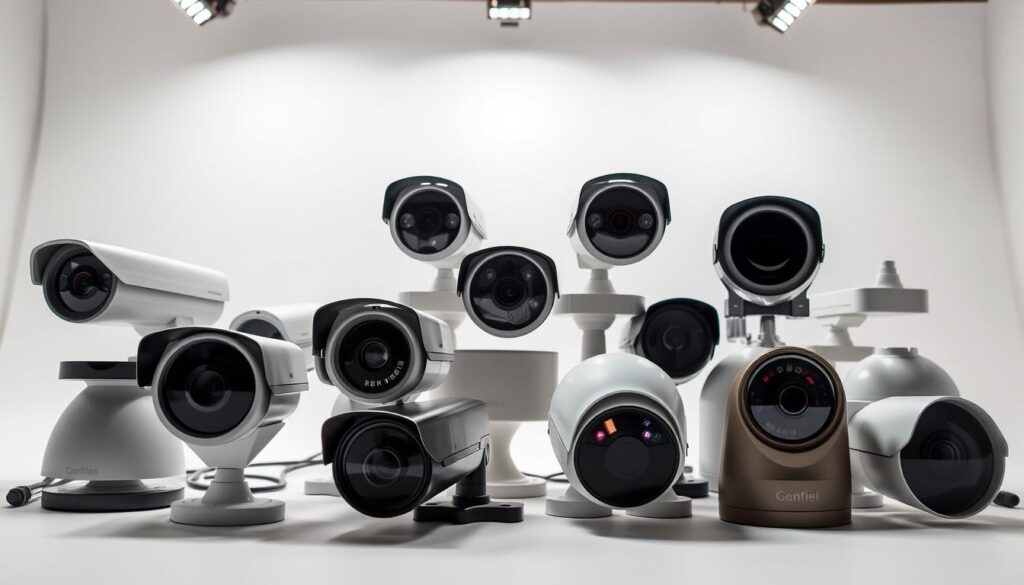
Choosing the right security cameras is key for home security. They add an extra layer of protection and peace of mind. It’s important to pick the right ones for your home.
Indoor vs. Outdoor Cameras
First, decide if you need indoor or outdoor cameras. Indoor cameras watch over your living spaces. Outdoor cameras handle weather and are more durable.
Outdoor cameras have weather resistance and night vision. They’re great for porches, backyards, and driveways.
Wired vs. Wireless Cameras
Next, choose between wired and wireless cameras. Wired cameras need a power source and are stable but harder to install. Wireless cameras are easier to set up but need batteries or recharging.
Resolution and Night Vision Capabilities
The resolution of a camera affects image quality. Higher resolution means clearer images, which is important for identifying people or license plates. Night vision is also key for cameras used in the dark.
Storage Options: Cloud vs. Local
Cameras have different storage options. Some save footage locally, while others use cloud storage for remote access. Think about your storage needs and accessibility when choosing.
For a detailed home security features comparison, look at different camera types. Top home security companies offer various cameras with features like facial recognition and motion tracking.
- Consider your home’s specific security needs.
- Think about the pros and cons of wired vs. wireless cameras.
- Look at the importance of resolution and night vision.
- Choose between cloud and local storage based on your needs.
Understanding Monitoring Options
The success of a home security system depends on its monitoring. It can be self-monitoring or professional. This choice affects how your system reacts to threats.
Self-Monitoring vs. Professional Monitoring
Self-monitoring sends alerts to your phone or computer. You handle the alarms yourself. On the other hand, professional monitoring uses trained staff who alert you and the police in emergencies. Self-monitoring is cheaper, but professional monitoring adds more security, even when you’re not home.
Monthly Costs and Contracts
Monitoring services vary in cost and contract length. Professional monitoring costs $10 to $50 monthly, based on the provider and services. Some offer month-to-month plans, while others require contracts lasting one to three years.
Response Times and Emergency Services
Response times vary between self-monitoring and professional monitoring. Professional services respond faster because they’re handled by experts. They also manage emergency calls like police or fire more efficiently.
Cellular Backup Considerations
A cellular backup is key for your system’s function during outages or internet issues. It keeps monitoring and alerts going, even without your main connection.
| Monitoring Type | Monthly Cost | Response Time |
|---|---|---|
| Self-Monitoring | $0 – $10 | Variable |
| Professional Monitoring | $10 – $50 | Fast |
When picking a home security system, knowing about monitoring options is key. By looking at affordable home security systems and considering response times and backup, you can choose wisely for your security.
Pre-Installation Planning
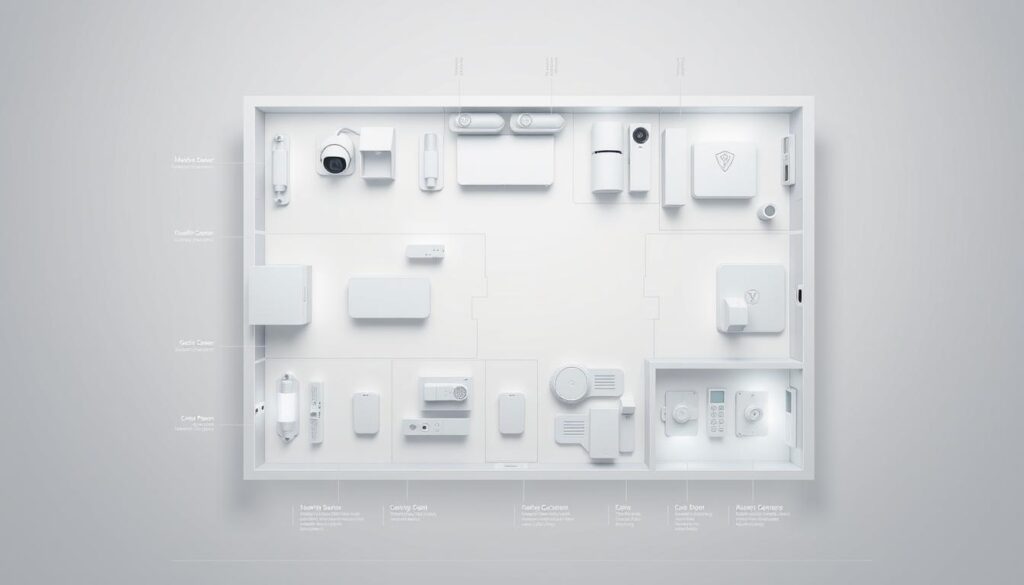
Planning before you install your home security system is key. A good plan helps pick the right parts and where to put them.
Creating a Security System Layout
Begin by mapping out your home’s layout. This will show you the best spots for your security gear. Think about where you need the most protection, like doors and hidden spots. A smart layout ensures you cover all areas.
Gathering Necessary Tools and Equipment
After planning, get all the tools and equipment you need. This includes sensors, cameras, and a control panel. Look at a home security comparison to pick the best for you.
Preparing Installation Areas
Get ready the spots for your security devices. Clear any clutter and make sure the surfaces are good for mounting.
Checking Wi-Fi Coverage and Strength
A solid Wi-Fi connection is vital for your system to work well. Check your Wi-Fi and think about upgrading your router or adding extenders if needed. For more tips, check out related security resources.
Step-by-Step Installation Guide for DIY Systems
If you like to do things yourself, setting up a DIY home security system is a good choice. This guide will help you through the process. You’ll learn how to make your home safe and secure.
Setting Up the Control Panel/Hub
The control panel or hub is the heart of your home security system. It’s important to set it up right for it to work well.
Positioning for Optimal Performance
Put the control panel in a central spot, like near your home’s main entrance. This makes it easy to reach and helps it talk to other parts of the system.
Power and Network Connections
Plug the control panel into a power source and connect it to your home network. Make sure your Wi-Fi is stable to avoid connection problems.
Installing Door and Window Sensors
Door and window sensors are key for catching intruders. They need to be installed correctly to work right.
Proper Alignment Techniques
Set the sensors up so they can see when doors or windows open. Secure them well to stop tampering.
Securing Sensors to Different Materials
Use the right fasteners for different materials (like wood, metal, or vinyl). This keeps the sensors in place and protects your doors and windows.
Mounting Motion Detectors
Motion detectors spot movement inside your home. Where you put them is very important.
Optimal Placement Height and Angle
Mount motion detectors high enough to cover the area you want but not so high it misses. Adjust the angle to get the best view.
Avoiding False Triggers
Keep motion detectors away from heat, direct sunlight, and drafts. This helps avoid false alarms.
Positioning and Installing Cameras
Security cameras watch your home and can scare off intruders.
Coverage Area Considerations
Put cameras in places that cover all weak spots, like doors, backyards, and garages.
Weatherproofing Outdoor Cameras
Make sure outdoor cameras can handle the weather. Clean their lenses often to keep the pictures clear.
By following these steps, you can set up a DIY home security system that works for you. Always test your system after you install it to make sure everything is working right.
Professional Installation: What to Expect
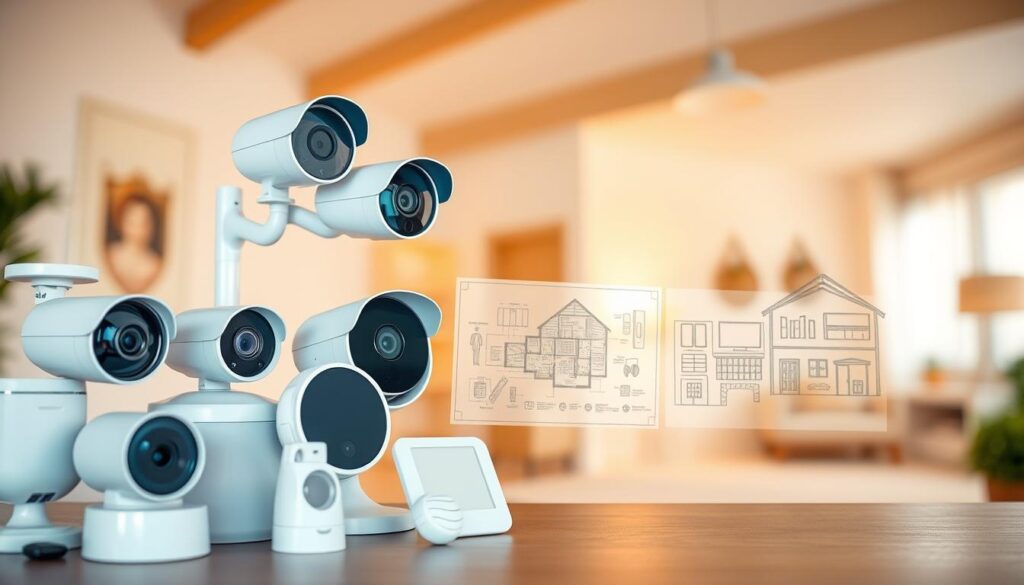
Getting a home security system installed by pros means a few important steps. You’ll get a detailed setup that includes scheduling, the installation itself, and training after it’s done. This ensures your system works perfectly.
Scheduling and Preparation
The first thing is to schedule the installation. You’ll work with the team to pick a good time. Many top home security companies offer flexible times to fit your schedule.
The Installation Process
The tech will then check out your home and figure out the best spots for security gear. This might include sensors for doors and windows, motion detectors, and cameras. They’ll make sure everything is set up right and works together well.
Post-Installation Setup and Training
Once it’s all set up, the tech will teach you how to use it. You’ll learn about the control panel, setting up alerts, and using the app. You’ll know how to turn the system on and off, handle alerts, and fix common problems.
Quality Checks and System Testing
Last, the team will do quality checks and tests to make sure it’s all working right. This is key to make sure your home security system is ready to protect you.
Connecting Your Security System to Wi-Fi and Mobile Devices
Setting up your home security system means linking it to your Wi-Fi and mobile devices. This lets you control and monitor your home from anywhere. It makes your security system more useful and flexible.
Setting Up the Mobile App
First, download and install the app for your security system. Most home security systems have apps for iOS and Android. After installing, log in with your account details or create a new one if needed.
Configuring Notifications and Alerts
Next, set up your notification preferences in the app. Choose what events trigger alerts and how you want to be notified. For a detailed home security package comparison, look at the alerts and notifications each system offers.
Troubleshooting Connection Issues
If you have trouble connecting your system, try a few things. Make sure your Wi-Fi is stable and your router is working. Restarting your router and security system hub might fix the problem.
Setting Up User Access and Permissions
Many systems let you create multiple user accounts with different access levels. This is great for families or if you need to give access to others. Decide what each user can do, like arm/disarm the system or watch live feeds.
By following these steps, you’ll get your home security system working well with your Wi-Fi and mobile devices. You’ll have a strong and affordable home security system that fits your needs.
Legal Considerations and Permits
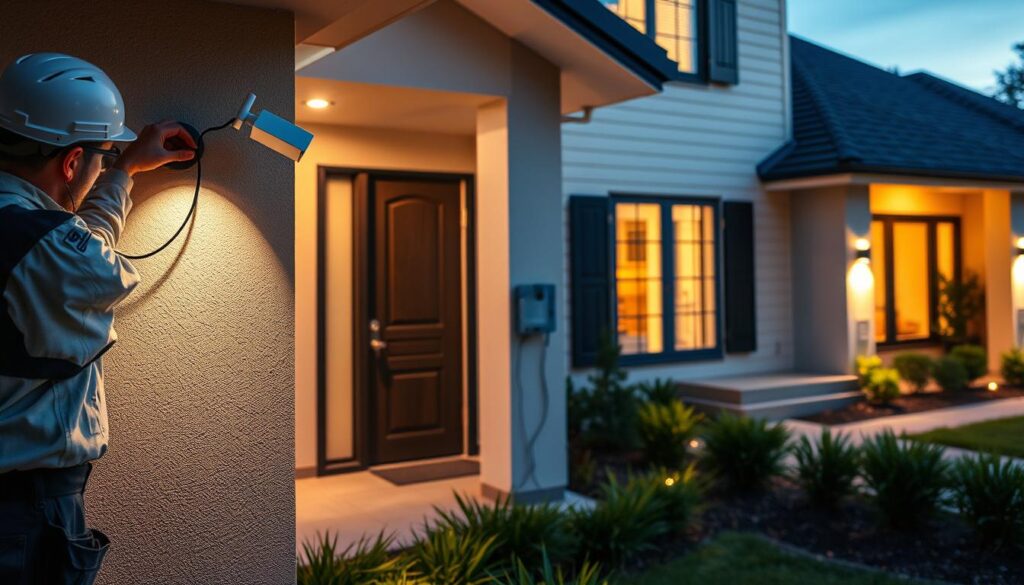
Before you install a home security system, you need to know the legal rules. Following these laws is key to avoid fines or legal trouble.
Alarm System Registration Requirements
In many places, you must register your alarm system with the police. This step helps cut down on false alarms. It also makes sure the police respond quickly when it’s really needed. Check with your local police to see what you need to do.
Video Recording Laws and Privacy
Video recording laws differ from state to state. Some states have rules about where and when you can use security cameras. It’s important to know these laws to protect people’s privacy.
HOA Restrictions and Considerations
If you live in a neighborhood with a Homeowners Association (HOA), there might be rules about security systems. Make sure to check the HOA rules before you install anything. This can help avoid any problems.
Testing Your Newly Installed Security System
To ensure your safety, it’s key to test your home security system after it’s installed. This step makes sure everything works right, giving you the security you need.
Conducting a Full System Test
A full system test checks if all parts of your security system are working. This includes door and window sensors, motion detectors, and cameras. Make sure each device is seen by the control panel and acts right when tested.
Testing Individual Components
Testing each part separately is important to find any problems. For example, see if door sensors set off the alarm when opened, and if motion detectors work when there’s movement. This detailed check helps find and fix any issues early.
Verifying Monitoring Connections
If you have professional monitoring, check if alerts are sent out right. This means checking the link between your system and the monitoring center. A good test shows that help will come if needed.
Creating a Testing Schedule
Regular checks are important to keep your system working well. Make a plan to test your system often, so it stays in top shape.
- Test your system weekly or monthly.
- Look for software updates.
- Change batteries when they’re low.
This way, you can keep your system updated and follow the best home security practices.
Maintaining Your Home Security System
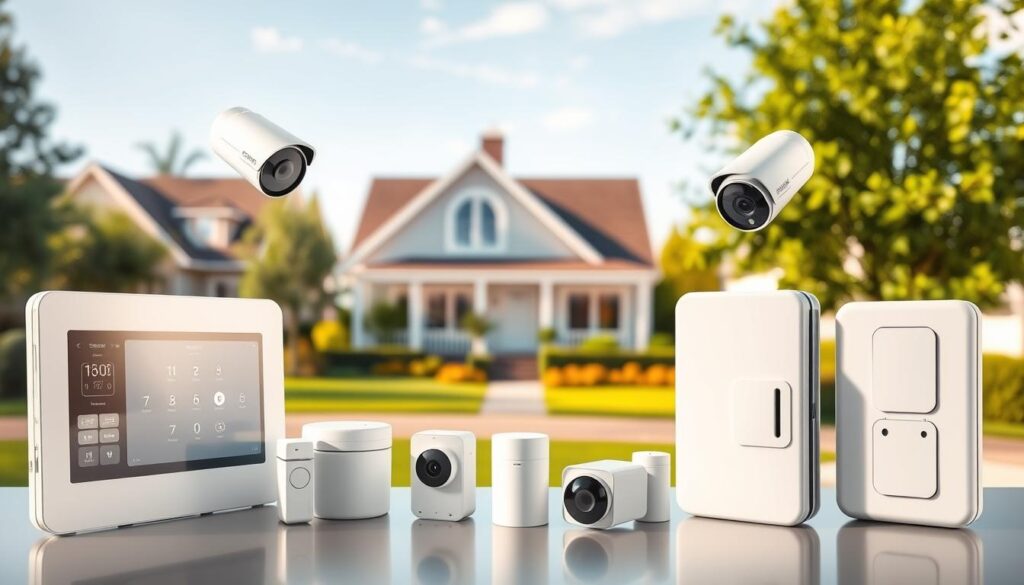
To keep your home safe, it’s key to regularly check your security system. A well-kept system keeps you and your family safe. It also makes sure you get the best from your home security investment.
Regular Testing Schedule
It’s important to test your system often. Check all parts like door sensors, motion detectors, and cameras. Try to test it once a week.
Battery Replacement Guidelines
If your system uses batteries, replacing them is a must. Systems usually tell you when batteries need changing. Change them quickly to keep your home secure.
Software Updates and Firmware
Keeping your system’s software and firmware updated is critical. Updates fix security issues and improve how your system works.
Seasonal Maintenance Considerations
Seasonal changes can affect your system. Cold weather can harm batteries, and leaves can block camera views. Regular checks in different seasons can solve these problems early.
| Maintenance Task | Frequency | Importance |
|---|---|---|
| System Testing | Weekly | High |
| Battery Replacement | As Needed | High |
| Software Updates | Monthly | High |
| Seasonal Checks | Quarterly | Medium |
By sticking to these maintenance tips, your home security system will keep protecting you. When picking a system, look for top home security companies that offer good maintenance support.
Troubleshooting Common Issues
It’s important to know how to fix common problems with your home security system. Even with an affordable home security system or a detailed home security package comparison, issues can pop up.
False Alarms and How to Prevent Them
False alarms can happen due to wrong settings, pets, or the environment. To avoid them, make sure your system’s sensitivity is right. Also, think about using pet-friendly motion detectors.
Testing your system often can help find and fix false alarm causes.
Connectivity Problems
Issues with connecting can mess up your home security system. First, check your internet and make sure your system’s software is current. If problems keep happening, try restarting your system or call your service provider for help.
Component Failures and Replacements
Parts can break down over time or because of defects. Look over your system’s parts, like sensors and cameras, for any problems. If something breaks, look in your manual or get a pro to fix or replace it.
When to Contact Professional Support
If you can’t fix a problem with your system, it’s time to get help. Reach out to your service provider for ongoing issues or if you’re not sure how to fix something. They can fix problems fast and keep your system working right.
Conclusion: Maximizing the Effectiveness of Your Home Security System
A good home security system is key to keeping your home and family safe. By comparing different systems, you can find the best one for you.
Getting a home security system can make your home safer and might even lower your insurance costs. Studies show many burglars look for alarm systems before they break in. This makes a security system a strong defense.
The price of a home security system varies. Basic DIY setups start at about $200, while professional installations can cost over $1,200. Monthly monitoring fees range from $20 to $60. For more details on costs, check out Eufy’s Home Security System Costs guide.
For the best results, pick a system that works well with your smart home devices. This can automate tasks like changing the thermostat or turning off lights. It saves time and money.
Knowing your security needs, choosing the right system, and keeping it up to date will keep your home safe. This gives you peace of mind for you and your family.




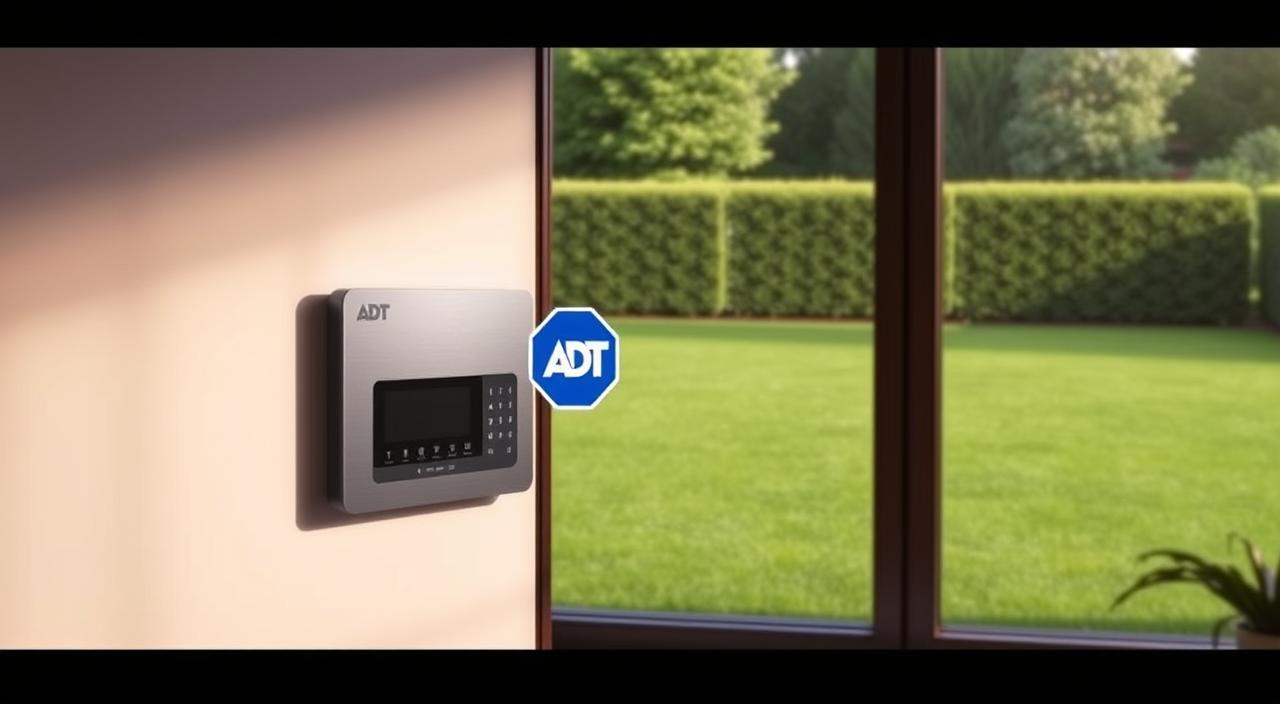
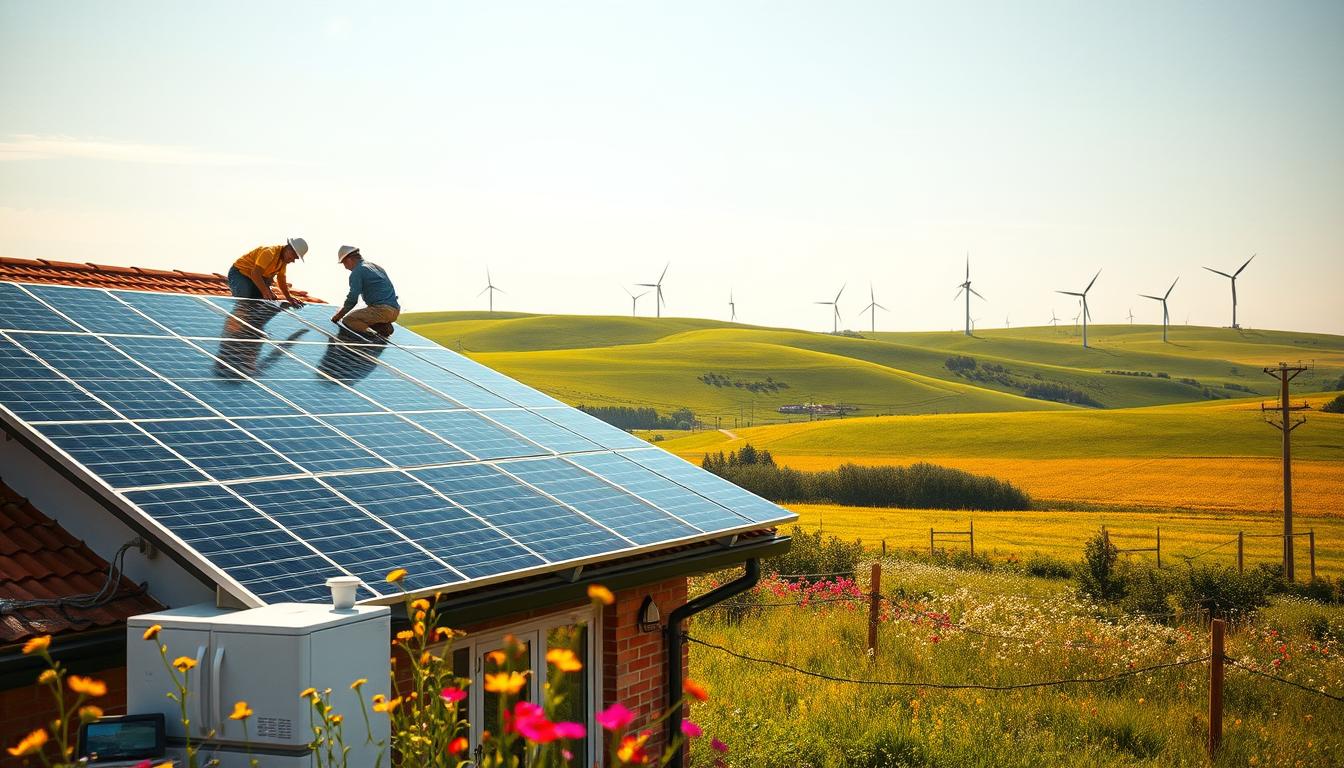
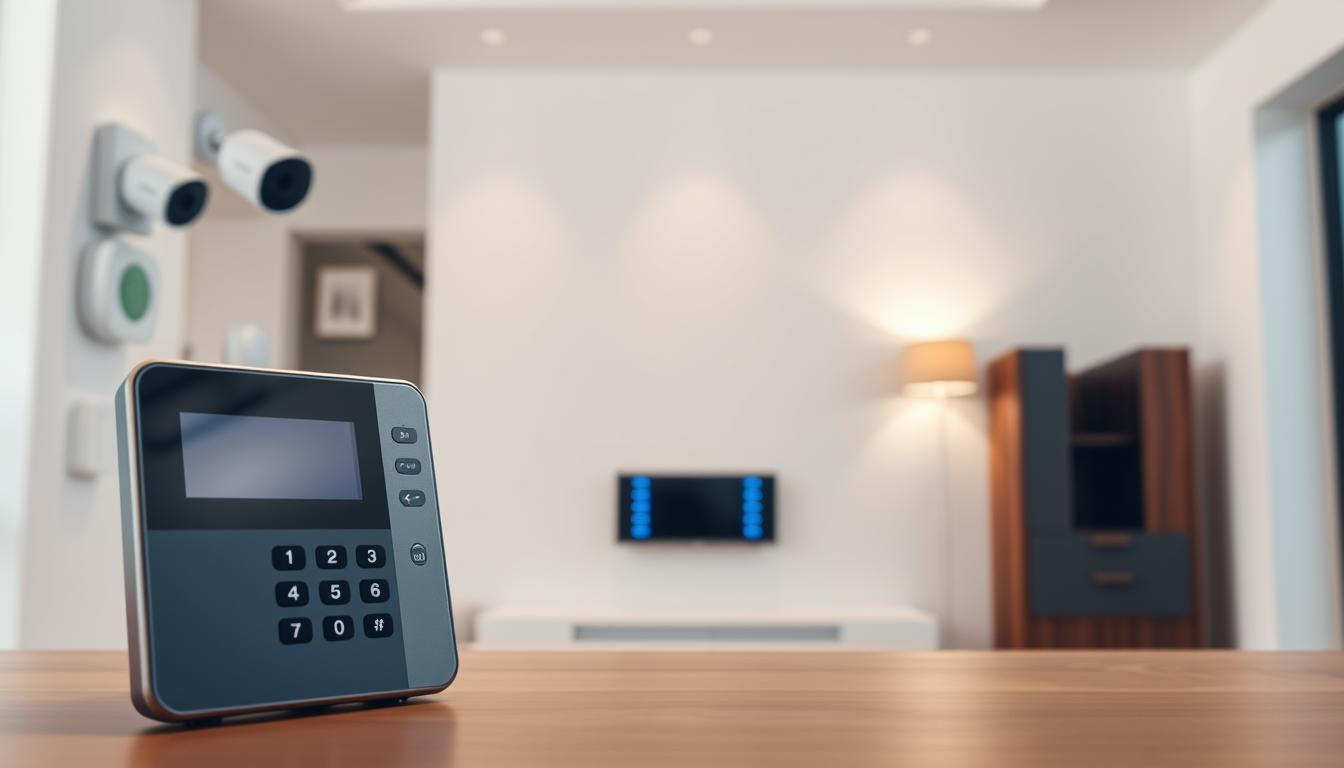
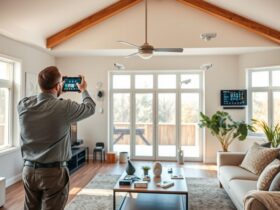
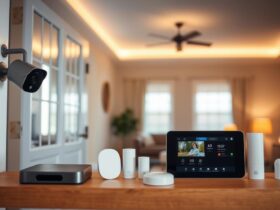
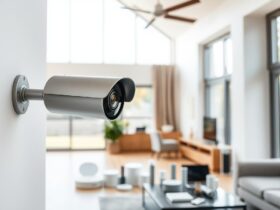
Leave a Reply